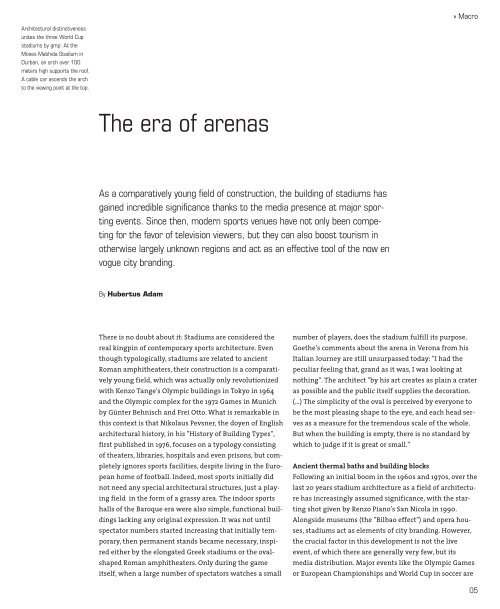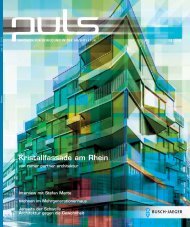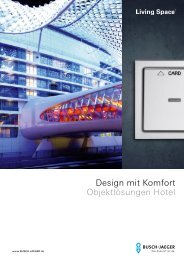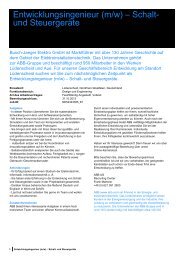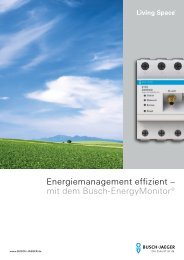Sports complexes that build identity - Busch-Jaeger Elektro GmbH
Sports complexes that build identity - Busch-Jaeger Elektro GmbH
Sports complexes that build identity - Busch-Jaeger Elektro GmbH
Create successful ePaper yourself
Turn your PDF publications into a flip-book with our unique Google optimized e-Paper software.
Architectural distinctiveness<br />
unites the three World Cup<br />
stadiums by gmp: At the<br />
Moses Mabhida Stadium in<br />
Durban, an arch over 100<br />
meters high supports the roof.<br />
A cable car ascends the arch<br />
to the viewing point at the top.<br />
The era of arenas<br />
As a comparatively young field of construction, the <strong>build</strong>ing of stadiums has<br />
gained incredible significance thanks to the media presence at major sporting<br />
events. Since then, modern sports venues have not only been competing<br />
for the favor of television viewers, but they can also boost tourism in<br />
otherwise largely unknown regions and act as an effective tool of the now en<br />
vogue city branding.<br />
By Hubertus Adam<br />
There is no doubt about it: Stadiums are considered the<br />
real kingpin of contemporary sports architecture. Even<br />
though typologically, stadiums are related to ancient<br />
Roman amphitheaters, their construction is a comparatively<br />
young field, which was actually only revolutionized<br />
with Kenzo Tange's Olympic <strong>build</strong>ings in Tokyo in 1964<br />
and the Olympic complex for the 1972 Games in Munich<br />
by Günter Behnisch and Frei Otto. What is remarkable in<br />
this context is <strong>that</strong> Nikolaus Pevsner, the doyen of English<br />
architectural history, in his "History of Building Types",<br />
first published in 1976, focuses on a typology consisting<br />
of theaters, libraries, hospitals and even prisons, but completely<br />
ignores sports facilities, despite living in the European<br />
home of football. Indeed, most sports initially did<br />
not need any special architectural structures, just a playing<br />
field in the form of a grassy area. The indoor sports<br />
halls of the Baroque era were also simple, functional <strong>build</strong>ings<br />
lacking any original expression. It was not until<br />
spectator numbers started increasing <strong>that</strong> initially temporary,<br />
then permanent stands became necessary, inspired<br />
either by the elongated Greek stadiums or the ovalshaped<br />
Roman amphitheaters. Only during the game<br />
itself, when a large number of spectators watches a small<br />
» Macro<br />
number of players, does the stadium fulfill its purpose.<br />
Goethe's comments about the arena in Verona from his<br />
Italian Journey are still unsurpassed today: "I had the<br />
peculiar feeling <strong>that</strong>, grand as it was, I was looking at<br />
nothing". The architect "by his art creates as plain a crater<br />
as possible and the public itself supplies the decoration.<br />
(…) The simplicity of the oval is perceived by everyone to<br />
be the most pleasing shape to the eye, and each head serves<br />
as a measure for the tremendous scale of the whole.<br />
But when the <strong>build</strong>ing is empty, there is no standard by<br />
which to judge if it is great or small."<br />
Ancient thermal baths and <strong>build</strong>ing blocks<br />
Following an initial boom in the 1960s and 1970s, over the<br />
last 20 years stadium architecture as a field of architecture<br />
has increasingly assumed significance, with the starting<br />
shot given by Renzo Piano's San Nicola in 1990.<br />
Alongside museums (the "Bilbao effect") and opera houses,<br />
stadiums act as elements of city branding. However,<br />
the crucial factor in this development is not the live<br />
event, of which there are generally very few, but its<br />
media distribution. Major events like the Olympic Games<br />
or European Championships and World Cup in soccer are<br />
05


